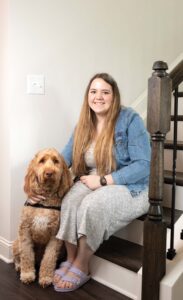Chords of Hope
Published on July 6th, 2023 by Jill Clendening.
Anna Grace Stephens, 18, calls the instant she met epilepsy specialist Shilpa Reddy, MD, MMHC, a “miracle moment.”
“The doctors at Vanderbilt got my seizures to stop when they had been uncontrolled for days,” said Anna Grace. “Then I was admitted to the EMU [Epilepsy Monitoring Unit] for the first time so they could start figuring out where my seizures were coming from.”
Reddy, assistant professor of Pediatrics, is director of the Pediatric Epilepsy Monitoring Unit at Monroe Carell Jr. Children’s Hospital at Vanderbilt.
“I remember when Dr. Reddy walked into the hospital room and asked if she could help us,” said her mother, Leigh Ann Stephens. “I tear up every time I think about it.”
When Reddy met the Stephens family, Anna Grace had been transported by ambulance from another hospital after she had been unsuccessfully treated for seizures that continued for three days.
Anna Grace needed a higher level of care, and the Pediatric Epilepsy Program at Monroe Carell is accredited by the National Association of Epilepsy Centers (NAEC) as a level 4 epilepsy center, which means it offers the professional expertise and facilities to provide the highest level of medical and surgical evaluation and treatment for patients with complex epilepsy, including inpatient video-EEG monitoring to evaluate children for epilepsy.
U.S. News & World Report consistently ranks Monroe Carell as a top provider of pediatric neurology care.
“As part of our pediatric epilepsy program, we treat patients who need evaluation for possible seizures and patients with known seizures, whether it be new onset epilepsy or difficult-to-treat genetic epilepsy syndromes,” said Reddy. “We see patients with epilepsy who may be good candidates for different therapies and treatments, including new medications, the ketogenic diet and surgery. We’re a full-service, comprehensive program.”
Epilepsy, which affects about 6 in 1,000 children, is a neurological disorder defined as recurrent, unprovoked seizures. During an epileptic seizure, many neurons in the brain fire or signal at the same time and much faster than normal. This surge of excessive electrical activity causes involuntary movements, sensations, emotions and behaviors, and the disturbance of normal neuronal activity can cause loss of awareness or responsiveness.
Monroe Carell’s Epilepsy Monitoring Unit Charts the Way Forward for Patients
There’s a button in the Epilepsy Monitoring Unit (EMU) at Monroe Carell Jr. Children’s Hospital at Vanderbilt that’s far more important than the room’s television remote. It’s called the event button.Read more »
Members of the pediatric epilepsy team at Monroe Carell also have specialization in treating other disorders often associated with epilepsy. For example, patients with genetic disorders, such as tuberous sclerosis, Rett syndrome and Angelman syndrome, are at high risk of developing epilepsy, and epileptologists run multidisciplinary clinics for each of these disorders. The team even meets with expectant mothers at The Reed Family Maternal Fetal Clinic at Vanderbilt if their unborn children have been diagnosed with a brain malformation, which can result in epilepsy.
“I let the family lead a lot of conversations, and my style of practicing medicine is very team based,” Reddy said. “My No. 1 question — whether we’re treating a child’s epilepsy with medication or diet or doing surgery — is, ‘What is important to your child and your family? How do we optimize your child’s quality of life without compromising other things?’ That’s going to look different for every single patient, depending on their age, their development, the reason for their epilepsy and, of course, the family’s situation. There’s never one right way to do things, and I like to always give families options and access to my thought process.”
When Anna Grace arrived at Monroe Carell, she was in a debilitating medical state known as status epilepticus, in which a person experiences a continuous, unremitting seizure or rapidly recurring seizures. If unresolved, it can be life threatening, with an estimated mortality of about 20%.
Before this crisis, Anna Grace had experienced epileptic seizures for two years. Her mother said from the moment of her daughter’s first seizure, their family was transformed forever.
“She fell down and started convulsing,” she said. “We took her to the emergency room at our local hospital. She was having an EEG and had another seizure while being monitored. She was diagnosed with epilepsy that day. I knew nothing about epilepsy at that point.”
Seizures are divided into four big categories: focal, generalized, focal and generalized combined, and unknown. More than 30 types of seizures within these categories have been identified by epilepsy specialists. Focal seizures originate in one part of the brain, and about 60% of people with epilepsy have these type of seizures. Generalized seizures occur when abnormal neuronal activity happens on both sides of the brain at the same time. Some people have seizures that begin as focal but then spread throughout the brain.
Anna Grace’s first recognized epilepsy event at age 11 was a tonic-clonic seizure, once called a grand mal seizure. These seizures cause a combination of symptoms, including stiffening of the body, rhythmic jerking of the limbs, and loss of consciousness.
Though she’d always excelled in academics, her seizures and the intense fatigue that followed them caused Anna Grace to begin struggling in sixth grade. Anti-seizure medications, prescribed one after another, weren’t working well and often had extreme side effects. One medication caused her to rage and scream uncontrollably at others with no warning. Another caused continual hunger, while one caused significant cognitive issues.
“With all the drug side effects, my quality of life wasn’t even worth it,” Anna Grace said. “It was either seizures or no quality of life. There was no middle ground.”
Leigh Ann Stephens was earning a bachelor’s degree in psychology and a master’s degree in social work when they began traveling three hours from East Tennessee to Nashville for Anna Grace’s care. The death of Leigh Ann’s father during this time made life even more sad and stressful. Leigh Ann’s mother, Susan Conners, is a registered nurse, and she chose to retire so she could stay with Anna Grace. School lessons were soon being done at home.
After a high-fat, low-carbohydrate, modified-Atkins diet proved unsuccessful, the Stephens family met another member of the pediatric epilepsy team, Robert Naftel, MD, a pediatric neurosurgeon. With surgery, the area of the brain where seizures begin can be removed or the seizure communication pathway can be disrupted to limit the spread of seizures to other areas of the brain.
For Anna Grace, an invasive diagnostic procedure, stereoelectroencephalography (SEEG), was needed to plan the surgery. With SEEG, electrodes were implanted directly into Anna Grace’s brain so the medical team could create a detailed map of where the seizure starts and spreads. After the seizure focus was identified, the epileptologists methodically tested that area to make sure it did not control any important functions such as movement, talking or vision.
The SEEG revealed a large portion of Anna Grace’s right frontal lobe was the origin of her seizures, and surgery was scheduled in March 2017.
“I leaned into my faith, and I relied on prayer,” Leigh Ann Stephens said. “We felt confident in the medical team, and we all had a kind of peace about it.”
Anna Grace was understandably conflicted. She wanted relief from the seizures, but she also feared losing facets of her life that gave her great joy. A very rare potential complication, based on the area of brain that was targeted for removal, was weakness or paralysis on her left side.
“I’m a music kid,” Anna Grace said. “I’ve been playing the piano since second grade. I thought, ‘You might take that away from me?’ Excuse me?’”

The surgery was successful, revealing a structural brain abnormality (focal cortical dysplasia, a group of disorganized neurons) as the cause for her epilepsy. For the next two years, Anna Grace had physical therapy and speech therapy sessions to rebuild her strength and function. And she had no seizures for three years. Then, in June 2020, her seizures made an unwelcome return.
“Out of nowhere, I fell, hit my head on the brick hearth and was bleeding everywhere,” Anna Grace said. “I was on the floor, and I thought, ‘Wow, I haven’t done this in a hot minute!’”
The family returned to Monroe Carell to find out why the seizures were happening again.
“Over time, because her epilepsy had been longstanding, her brain created new networks or there were existing networks that were unmasked over time,” Reddy said. “So, she had a recurrence of her seizures.”
The team then recommended implantation of a device called a vagus nerve stimulator, which sends electrical impulses up the vagus nerve into the brain to alter brain activity. The device proved to be only moderately successful.
“Epilepsy is hard and unpredictable, and through it all, it is important to focus on quality of life and what will best help the patient and their family live their best life,” Reddy said. “Working together by trying new medications, considering new procedures, and forming relationships is a vital part of treating epilepsy.”
The Stephenses have decided to hold off on any other procedures, hoping to wait until Anna Grace’s brain fully matures at age 25 to see what her new normal looks like then. In the meantime, she takes antiseizure medication and is under the watchful eye of a new member of the family, her seizure-response service dog, a 50-pound Pyradoodle named Sully.
When Sully spots behavior that signals a seizure, he barks frantically and loudly to alert others. During a seizure, and as it subsides, Sully comforts Anna Grace and often licks her to help her return to awareness. The family credits Sully for saving her life on more than one occasion.
Anna Grace’s seizures have been less frequent than before she had surgery, when she was experiencing up to multiple seizures a day. She currently has “small” seizures which cause her to stare blankly into space for short periods as well as tonic-clonic seizures that usually occur about three to six months apart. In recent months, she’s had a tonic-clonic seizure once a month, which Leigh Ann attributes to some added stress.
The family still walks on eggshells, dreading the next seizure. But many days are also filled with planning for exciting, future milestones.
Anna Grace plans to attend college near her home, with the goal of earning a PhD in English and becoming a college professor. She also wants to write a book, possibly about her experiences with epilepsy.
“I mean, I’m 18, and I could probably write a pretty large autobiography at this point,” she said.




